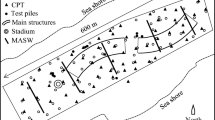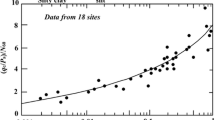Abstract
In this study, the pressuremeter modulus (EM) and the unload–reload modulus (Eur) consisted of a wide range of data were correlated to blow counts (N60) using a maximum of 50 blows/300 mm and the extrapolated N60 of 300 blows/300 mm. A 3D model and statistical analysis were used to provide relevant justifications for the selection of this extrapolation method, considering that N60 was limited to 50 blows. In generating a 3D model, the N60 profile was developed using the inverse distance weighting method for predicting unsampled data between boreholes. Correlations were established for the sandy silt soil type that was observed as the dominant lithology in the Klang Valley Mass Rapid Transit line 1 project in Kuala Lumpur, Malaysia. A total 52 pressuremeter test and standard penetration test data pairs were obtained at depths ranging from 6 to 41.7 m within the Kenny Hill Formation (KHF) and the contact zone between the KHF and the limestone formation. This contact zone has shown distinct geological features with the characteristic of a lower N60 value underlying stiff strata. According to the EM/Eur ratio, the maximum value of 7 indicated that this zone is unpredicted in initial and unload–reload stiffness compared to the non-contact zone (the KHF only), with a maximum ratio of 3. Therefore, separate correlations were established to distinguish these zones. Strong correlations between N60 and EM were identified by splitting these zones. The proposed correlation was then compared with the previous research.

























Similar content being viewed by others
References
Cheshomi, A.; Ghodrati, M.: Estimating Menard pressuremeter modulus and limit pressure from SPT in silty sand and silty clay soils. A case study in Mashhad, Iran. Geomech. Geoengin. 10, 194–202 (2015). https://doi.org/10.1080/17486025.2014.933894
Batilas, A.V.; Pelekis, P.C.; Roussos, P.G.; Athanasopoulos, G.A.: SPT energy measurements: manual vs. automatic hammer release. Geotech. Geol. Eng. 35(2), 879–888 (2017). https://doi.org/10.1007/s10706-016-0138-z
dos Santos, M.D.; Bicalho, K.V.: Proposals of SPT-CPT and DPL-CPT correlations for sandy soils in Brazil. J. Rock Mech. Geotech. Eng. 9, 1152–1158 (2017). https://doi.org/10.1016/j.jrmge.2017.08.001
Akca, N.: Correlation of SPT–CPT data from the United Arab Emirates. Eng. Geol. 67, 219–231 (2003). https://doi.org/10.1016/S0013-7952(02)00181-3
Sivrikaya, O.; Toǧrol, E.: Determination of undrained strength of fine-grained soils by means of SPT and its application in Turkey. Eng. Geol. 86, 52–69 (2006). https://doi.org/10.1016/j.enggeo.2006.05.002
Ameratunga, J.; Sivakugan, N.; Das, B.M.: Correlations of soil and rock properties in geotechnical engineering. Springer India, New Delhi (2016)
Lukas, R.G.: Pressuremeter testing for foundation design. In: Hussein, M.H., Anderson, J.B., Camp, W.M. (eds.) The Art of Foundation Engineering Practice, pp. 371–379. American Society of Civil Engineers, Virginia (2010)
Schanz, T.; Vermeer, P.A.; Bonnier, P.G.: The hardening soil model: formulation and verification. In: Beyond 2000 in Computational Geotechnics, pp. 281–296. Balkema, Rotterdam (1999)
Mair, R.J.; Wood, D.M.: Pressuremeter Testing Methods and Interpretation. CIRIA, London (1987). (ISSN:0-408-02434-8)
Bozbey, I.; Togrol, E.: Correlation of standard penetration test and pressuremeter data: a case study from Istanbul, Turkey. Bull. Eng. Geol. Environ. 69, 505–515 (2010). https://doi.org/10.1007/s10064-009-0248-4
Chiang, Y.C.; Ho, Y.M.: Pressuremeter method for foundation design in Hong Kong. In: Proceedings of Sixth Southeast Asian Conference on Soil Engineering, vol. 1, pp. 31–42 (1980)
Kayabasi, A.: Prediction of pressuremeter modulus and limit pressure of clayey soils by simple and non-linear multiple regression techniques: a case study from Mersin, Turkey. Environ. Earth Sci. 66, 2171–2183 (2012). https://doi.org/10.1007/s12665-011-1439-4
Yagiz, S.; Akyol, E.; Sen, G.: Relationship between the standard penetration test and the pressuremeter test on sandy silty clays: a case study from Denizli. Bull. Eng. Geol. Environ. 67, 405–410 (2008). https://doi.org/10.1007/s10064-008-0153-2
Phoon, K.; Kulhawy, F.H.: Evaluation of geotechnical property variability. Can. Geotech. J. 36, 625–639 (1999). https://doi.org/10.1139/t99-039
Lim, A.; Ou, C.Y.: Stress paths in deep excavations under undrained conditions and its influence on deformation analysis. Tunn. Undergr. Sp. Technol. 63, 118–132 (2017). https://doi.org/10.1016/j.tust.2016.12.013
Chang, M.; Zhu, H.: Construction effect on load transfer along bored piles. J. Geotech. Geoenviron. Eng. 130, 426–437 (2000). https://doi.org/10.1061/(ASCE)1090-0241(2004)130:4(426)
Jamiolkowski, M.; Lo Presti D.C.F.; Pallara O.: Role of in-situ testing in geotechnical earthquake engineering. In: Proceeding of the 3rd International Conference on Recent Advances in Geotechnical Earthquake Engineering and Soil Dynamics, St. Louis, Missouri, 2–7 April, vol. II, pp. 1523–1546 (1995)
Law, K.H.; Othman, S.Z.; Hashim, R.; Ismail, Z.: Determination of soil stiffness parameters at a deep excavation construction site in Kenny Hill Formation. Meas. J. Int. Meas. Confed. 47, 645–650 (2014). https://doi.org/10.1016/j.measurement.2013.09.030
Lee, C.P.: Palaeozoic stratigraphy. In: Hutchison, C.S., Tan, D.N.K. (eds.) Geology of Peninsular Malaysia, 1st edn, pp. 55–86. The University of Malaya and The Geological Society of Malaysia, Kuala Lumpur (2009)
Hutchison, C.S.; Tan, D.N.K.: Geology of Peninsular Malaysia. University of Malaya, Kuala Lumpur (2009)
Tan, B.K.: Urban geology of Kuala Lumpur and Ipoh, Malaysia. In: International Association of Engineering Geology (IAEG2006), pp. 1–7. London: The Geological Society of London (2006)
Geological map of peninsular Malaysia.: Department of Mineral and Geoscience Malaysia (2012)
Raj, J.K.: Geomorphology. In: Hutchison, C.S.; Tan, D.N.K. (eds.) Geology of Peninsular Malaysia, 1st edn, pp. 5–29. University of Malaya, Geological Society of Malaysia, Kuala Lumpur (2006)
Mohamed, Z.; Rafek, A.G.; Komoo, I.: Characterisation and classification of the physical deterioration of tropically Weathered Kenny Hill rock for civil works. Electron. J. Geotech. Eng. 12, 1–26 (2007)
BS1377: British Standard Methods of Test for Soils for civil engineering purposes: Part 9: In-Situ Tests. British Standards Institution, London (1990)
Seed, H.B.; Idriss, I.M.; Arango, I.: Evaluation of liquefaction potential using field performance data. J. Geotech. Eng. (1983). https://doi.org/10.1061/(ASCE)0733-9410(1983)109:3(458)
Cavallaro, A.; Grasso, S.; Maugeri, M.: Small strain stiffness by MPTs for site response analysis. In: Proceedings of the International Symposium on 60 Years of Pressuremeters, ISP’7—Pressio, Hammamet, 1–2 May, pp. 347–356 (2015)
Likitlersuang, S.; Surarak, C.; Wanatowski, D.; Oh, E.; Balasubramaniam, A.: Geotechnical parameters from pressuremeter tests for MRT blue line extension in Bangkok. Geomech. Eng. 5(2), 99–118 (2013). https://doi.org/10.12989/gae.2013.5.2.099
Schnaid, F.: In Situ Testing in Geomechnaincs: The Main Tests. Taylor and Francis, Oxford (2009)
Baguelin, F.; Jezequel, J.F.; Shields, D.H.: The Pressuremeter and Foundation Engineering. Trans Tech. Publication, Clausthal (1978)
ASTM-D4719.: Standard Test Method for Prebored Pressuremeter Testing in Soils. ASTM International, West Conshohocken, PA (2000)
Isik, N.S.; Ulusay, R.; Doyuran, V.: Deformation modulus of heavily jointed–sheared and blocky greywackes by pressuremeter tests: numerical, experimental and empirical assessments. Eng. Geol. 101(3–4), 269–282 (2008)
Bowles, J.E.: Foundation Analysis and Design, 5th edn. McGraw- Hill, New York (1997)
BS5930: Code of Practice for Site Investigations. Section 6. British Standard Institution, London (1999)
Google Maps.: Kuala Lumpur city center. https://www.maps.google.com. Accessed 11 Jan 2018
Varghese, P.C.: Foundation Engineering. PHI Learning Pvt. Ltd, New Delhi (2005)
Kulhawy, F.H.; Trautmann, C.H.: Estimation of In-Situ Test Uncertainty. Uncertainty in the Geologic Environment, pp. 269–286. ASCE, Madison (1996)
Koch, G.S.; Link, R.F.: The coefficient of variation; a guide to the sampling of ore deposits. Econ. Geol. 66(2), 293–301 (1971)
GEO: Guide to Site Investigation (Geoguide 2). Geotechnical Engineering Office, Hong Kong (1987)
Anbazhagan, P.; Parihar, A.; Rashmi, H.N.: Review of correlations between SPT N and shear modulus: a new correlation applicable to any region. Soil Dyn. Earthq. Eng. 36, 52–69 (2012). https://doi.org/10.1016/j.soildyn.2012.01.005
Imai, T.; Tonouchi, K.: Correlation of N value with S-wave velocity and shear modulus. In: Penetration Testing Proceedings of 2nd European Symposium, Amsterdam (1982)
Anwar, M.B.: Correlation between PMT and SPT results for calcareous soil. HBRC J. (2016). https://doi.org/10.1016/j.hbrcj.2016.03.001
Huat, B.B.; Toll, D.G.; Prasad, A.: Handbook of Tropical Residual Soils Engineering. CRC Press, Boca Raton (2012)
Tan, B.K.: Engineering geology in Malaysia—some case studies. Bull. Geol. Soc. Malaysia 64, 65–79 (2017)
Touch, S.; Likitlersuang, S.; Pipatpongsa, T.: 3D geological modelling and geotechnical characteristics of Phnom Penh subsoils in Cambodia. Eng. Geol. 178, 58–69 (2014). https://doi.org/10.1016/j.enggeo.2014.06.010
Zhu, L.; Zhang, C.; Li, M.; Pan, X.; Sun, J.: Building 3D solid models of sedimentary stratigraphic systems from borehole data: an automatic method and case studies. Eng. Geol. 127, 1–13 (2012). https://doi.org/10.1016/j.enggeo.2011.12.001
Lu, G.Y.; Wong, D.W.: An adaptive inverse-distance weighting spatial interpolation technique. Comput. Geosci. 34(9), 1044–1055 (2008). https://doi.org/10.1016/j.cageo.2007.07.010
Bonham-Carter, G.F.: Geographic information systems for geo-scientists: modelling with GIS. Elsevier, Pergamon (1994)
Burrough, P.A.; McDonnell, R.A.: Creating Continuous Surfaces from Point Data. Principles of Geographic Information Systems. Oxford University Press, Oxford (1998)
Kong, T.B.; Komoo, I.: Urban geology: case study of Kuala Lumpur, Malaysia. Eng. Geol. 28(1–2), 71–94 (1990). https://doi.org/10.1016/0013-7952(90)90034-X
Rockware.: Rockworks17 Software Help. Boulder (2016)
Smith, G.N.: Probability and Statistics in Civil Engineering. Collins, London (1986)
Gue, S.S.; Tan, Y.C.: The foundation system for Berjaya Times Square. Seminar on Mega Projects: A Study on Civil Engineering Projects, University Technology Malaysia, Johor Bharu, Malaysia (2001)
Baker, Jr, C.N.; Drumright, E.; Joseph, L.M.; Azam, I.: Foundation Design and Performance of the World's Tallest Building, Petronas Towers (1998)
Clayton, C.R.I.; Matthews, M.C.; Simons, N.E.: Site Investigation, 2nd edn. Blackwell, Cambridge (1995)
Townsend, F.C.: Geotechnical characteristics of residual soils. J. Geotech. Eng. (1985). https://doi.org/10.1061/(ASCE)0733-9410(1985)111:1(77)
Balasubramaniam, A.S.; Bergado, D.T.; Sivandran, C.: Engineering behavior of soil in Southeast Asia. Geotechnical engineering in Southeast Asia. A commemorative volume of the Southeast Asian Geotechnical Society (1985)
Acknowledgements
The author acknowledges the financial support provided by Grant FRGS: MINISTRY OF EDUCATION MALAYSIA for the topic of “Establishment of Kenny Hill Small Strain Stiffness Parameter and Stiffness Degradation Curve for Sustainable Urban Underground Infrastructure Development in Malaysia” (FRGS 1/2018/TK08/USM/02/2). The first author is grateful to Universiti Malaysia Perlis and the Ministry of Education Malaysia for a study leave in Universiti Sains Malaysia. Thanks to the MRT Corp for the data and technical support.
Author information
Authors and Affiliations
Corresponding author
Rights and permissions
About this article
Cite this article
Zaki, M.F.M., Ismail, M.A.M. & Govindasamy, D. Correlation Between SPT and PMT for Sandy Silt: A Case Study from Kuala Lumpur, Malaysia. Arab J Sci Eng 45, 8281–8302 (2020). https://doi.org/10.1007/s13369-020-04684-3
Received:
Accepted:
Published:
Issue Date:
DOI: https://doi.org/10.1007/s13369-020-04684-3




